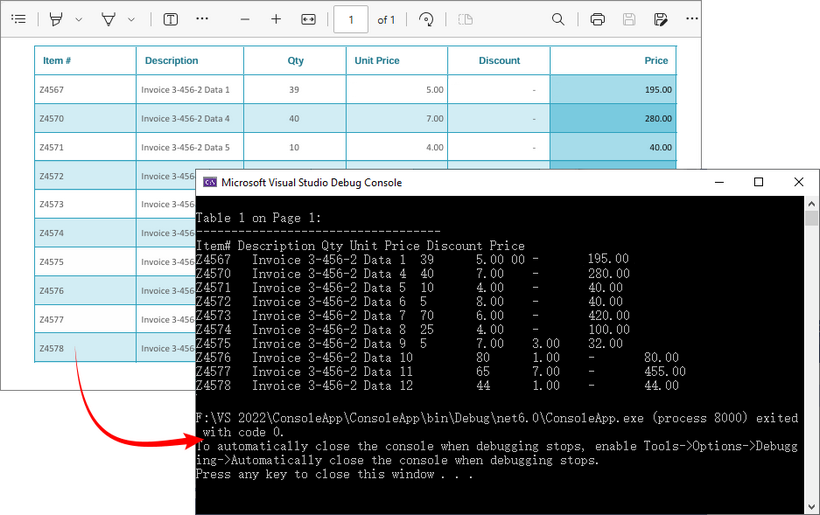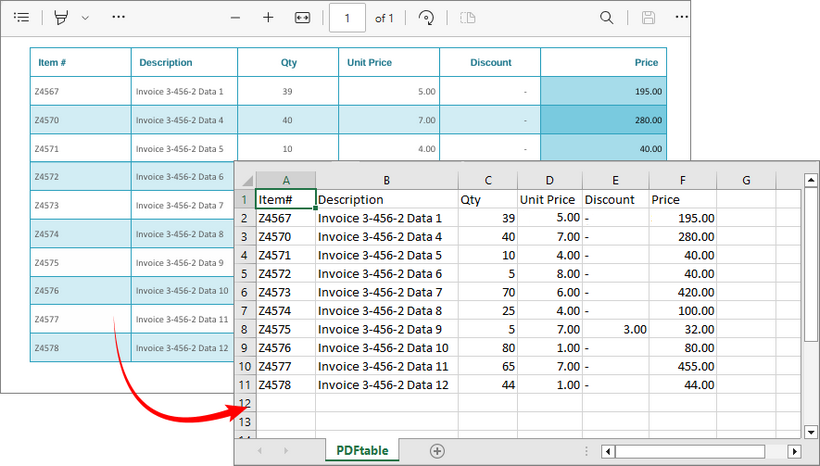 Extracting tables from PDF files is a common requirement in data processing, reporting, and automation tasks. PDFs are widely used for sharing structured data, but extracting tables programmatically can be challenging due to their complex layout. Fortunately, with the right tools, this process becomes straightforward. In this guide, we’ll explore how to extract tables from PDF in C# using the Spire.PDF for .NET library, and export the results to TXT and CSV formats for easy reuse.
Extracting tables from PDF files is a common requirement in data processing, reporting, and automation tasks. PDFs are widely used for sharing structured data, but extracting tables programmatically can be challenging due to their complex layout. Fortunately, with the right tools, this process becomes straightforward. In this guide, we’ll explore how to extract tables from PDF in C# using the Spire.PDF for .NET library, and export the results to TXT and CSV formats for easy reuse.
Table of Contents:
- Prerequisites for Reading PDF Tables in C#
- Understanding PDF Table Structure
- How to Extract Tables from PDF in C#
- Extract PDF Tables to a Text File in C#
- Export PDF Tables to CSV in C#
- Conclusion
- FAQs
Prerequisites for Reading PDF Tables in C#
Spire.PDF for .NET is a powerful library for processing PDF files in C# and VB.NET. It supports a wide range of PDF operations, including table extraction, text extraction, image extraction, and more.
The easiest way to add the Spire.PDF library is via NuGet Package Manager.
1. Open Visual Studio and create a new C# project. (Here we create a Console App)
2. In Visual Studio, right-click your project > Manage NuGet Packages.
3. Search for “Spire.PDF” and install the latest version.
Understanding PDF Table Structure
Before coding, let’s clarify how PDFs store tables. Unlike Excel (which explicitly defines rows/columns), PDFs use:
- Text Blocks: Individual text elements positioned with coordinates.
- Borders/Lines: Visual cues (horizontal/vertical lines) that humans interpret as table edges.
- Spacing: Consistent gaps between text blocks to indicate cells.
The Spire.PDF library infers table structure by analyzing these visual cues, matching text blocks to rows/columns based on proximity and alignment.
How to Extract Tables from PDF in C#
If you need a quick way to preview table data (e.g., debugging or verifying extraction), printing it to the console is a great starting point.
Key methods to extract data from a PDF table:
- PdfDocument: Represents a PDF file.
- LoadFromFile: Loads the PDF file for processing.
- PdfTableExtractor: Analyzes the PDF to detect tables using visual cues (borders, spacing).
- ExtractTable(pageIndex): Returns an array of PdfTable objects for the specified page.
- GetRowCount()/GetColumnCount(): Retrieve the dimensions of each table.
- GetText(rowIndex, columnIndex): Extracts text from the cell at the specified row and column.
using Spire.Pdf;
using Spire.Pdf.Utilities;
namespace ExtractPdfTable
{
class Program
{
static void Main(string[] args)
{
// Create a PdfDocument object
PdfDocument pdf = new PdfDocument();
// Load a PDF file
pdf.LoadFromFile("invoice.pdf");
// Initialize an instance of PdfTableExtractor class
PdfTableExtractor extractor = new PdfTableExtractor(pdf);
// Loop through the pages
for (int pageIndex = 0; pageIndex < pdf.Pages.Count; pageIndex++)
{
// Extract tables from a specific page
PdfTable[] tableList = extractor.ExtractTable(pageIndex);
// Determine if the table list is null
if (tableList != null && tableList.Length > 0)
{
int tableNumber = 1;
// Loop through the table in the list
foreach (PdfTable table in tableList)
{
Console.WriteLine($"\nTable {tableNumber} on Page {pageIndex + 1}:");
Console.WriteLine("-----------------------------------");
// Get row number and column number of a certain table
int row = table.GetRowCount();
int column = table.GetColumnCount();
// Loop through rows and columns
for (int i = 0; i < row; i++)
{
for (int j = 0; j < column; j++)
{
// Get text from the specific cell
string text = table.GetText(i, j);
// Print cell text to console with a separator
Console.Write($"{text}\t");
}
// New line after each row
Console.WriteLine();
}
tableNumber++;
}
}
}
// Close the document
pdf.Close();
}
}
}
When to Use This Method
- Quick debugging or validation of extracted data.
- Small datasets where you don’t need persistent storage.
Output: Retrieve PDF table data and output to the console

Extract PDF Tables to a Text File in C#
For lightweight, human-readable storage, saving tables to a text file is ideal. This method uses StringBuilder to efficiently compile table data, preserving row breaks for readability.
Key features of extracting PDF tables and exporting to TXT:
- Efficiency: StringBuilder minimizes memory overhead compared to string concatenation.
- Persistent Storage: Saves data to a text file for later review or sharing.
- Row Preservation: Uses \r\n to maintain row structure, making the text file easy to scan.
using Spire.Pdf;
using Spire.Pdf.Utilities;
using System.Text;
namespace ExtractTableToTxt
{
class Program
{
static void Main(string[] args)
{
// Create a PdfDocument object
PdfDocument pdf = new PdfDocument();
// Load a PDF file
pdf.LoadFromFile("invoice.pdf");
// Create a StringBuilder object
StringBuilder builder = new StringBuilder();
// Initialize an instance of PdfTableExtractor class
PdfTableExtractor extractor = new PdfTableExtractor(pdf);
// Declare a PdfTable array
PdfTable[] tableList = null;
// Loop through the pages
for (int pageIndex = 0; pageIndex < pdf.Pages.Count; pageIndex++)
{
// Extract tables from a specific page
tableList = extractor.ExtractTable(pageIndex);
// Determine if the table list is null
if (tableList != null && tableList.Length > 0)
{
// Loop through the table in the list
foreach (PdfTable table in tableList)
{
// Get row number and column number of a certain table
int row = table.GetRowCount();
int column = table.GetColumnCount();
// Loop through the rows and columns
for (int i = 0; i < row; i++)
{
for (int j = 0; j < column; j++)
{
// Get text from the specific cell
string text = table.GetText(i, j);
// Add text to the string builder
builder.Append(text + " ");
}
builder.Append("\r\n");
}
}
}
}
// Write to a .txt file
File.WriteAllText("ExtractPDFTable.txt", builder.ToString());
}
}
}
When to Use This Method
- Archiving table data in a lightweight, universally accessible format.
- Sharing with teams that need to scan data without spreadsheet tools.
- Using as input for basic scripts (e.g., PowerShell) to extract specific values.
Output: Extract PDF table data and save to a text file.

Pro Tip: For VB.NET demos, convert the above code using our C# ⇆ VB.NET Converter.
Export PDF Tables to CSV in C#
CSV (Comma-Separated Values) is the industry standard for tabular data, compatible with Excel, Google Sheets, and databases. This method formats the extracted tables into a valid CSV file by quoting cells and handling special characters.
Key features of extracting tables from PDF to CSV:
- StreamWriter: Writes data incrementally to the CSV file, reducing memory usage for large PDFs.
- Quoted Cells: Cells are wrapped in double quotes (" ") to avoid misinterpreting commas within text as column separators.
- UTF-8 Encoding: Supports special characters in cell text.
- Spreadsheet Ready: Directly opens in Excel, Google Sheets, or spreadsheet tools for analysis.
using Spire.Pdf;
using Spire.Pdf.Utilities;
using System.Text;
namespace ExtractTableToCsv
{
class Program
{
static void Main(string[] args)
{
// Create a PdfDocument object
PdfDocument pdf = new PdfDocument();
// Load a PDF file
pdf.LoadFromFile("invoice.pdf");
// Create a StreamWriter object for efficient CSV writing
using (StreamWriter csvWriter = new StreamWriter("PDFtable.csv", false, Encoding.UTF8))
{
// Create a PdfTableExtractor object
PdfTableExtractor extractor = new PdfTableExtractor(pdf);
// Loop through the pages
for (int pageIndex = 0; pageIndex < pdf.Pages.Count; pageIndex++)
{
// Extract tables from a specific page
PdfTable[] tableList = extractor.ExtractTable(pageIndex);
// Determine if the table list is null
if (tableList != null && tableList.Length > 0)
{
// Loop through the table in the list
foreach (PdfTable table in tableList)
{
// Get row number and column number of a certain table
int row = table.GetRowCount();
int column = table.GetColumnCount();
// Loop through the rows
for (int i = 0; i < row; i++)
{
// Creates a list to store data
List<string> rowData = new List<string>();
// Loop through the columns
for (int j = 0; j < column; j++)
{
// Retrieve text from table cells
string cellText = table.GetText(i, j).Replace("\"", "\"\"");
// Add the cell text to the list and wrap in double quotes
rowData.Add($"\"{cellText}\"");
}
// Join cells with commas and write to CSV
csvWriter.WriteLine(string.Join(",", rowData));
}
}
}
}
}
}
}
}
When to Use This Method
- Data analysis (import into Excel for calculations).
- Migrating PDF tables to databases (e.g., SQL Server, PostgreSQL, MySQL).
- Collaborating with teams that rely on spreadsheets.
Output: Parse PDF table data and export to a CSV file.

Recommendation: Integrate with Spire.XLS for .NET to extract tables from PDF to Excel directly.
Conclusion
This guide has outlined three efficient methods for extracting tables from PDFs in C#. By leveraging the Spire.PDF for .NET library, you can automate the PDF table extraction process and export results to console, TXT, or CSV for further analysis. Whether you’re building a data pipeline, report generator, or business tool, these approaches streamline workflows, save time, and minimize human error.
Refer to the online documentation and obtain a free trial license here to explore more advanced PDF operations.
FAQs
Q1: Why use Spire.PDF for .NET to extract tables?
A: Spire.PDF provides a dedicated PdfTableExtractor class that detects tables based on visual cues (borders, spacing, and text alignment), simplifying the process of parsing structured data from PDFs.
Q2: Can Spire.PDF extract tables from scanned (image-based) PDFs?
A: No. The .NET PDF library works only with text-based PDFs (where text is selectable). For scanned PDFs, use Spire.OCR to extract text before parsing tables.
Q3: Can I extract tables from multiple PDFs at once?
A: Yes. To batch-process multiple PDFs, use Directory.GetFiles() to list all PDF files in a folder, then loop through each file and run the extraction logic. For example:
string[] pdfFiles = Directory.GetFiles(@"C:\Invoices\", "*.pdf");
foreach (string file in pdfFiles)
{
// Run extraction code for each file
}
Q4: How can I improve performance when extracting tables from large PDFs?
A: For large PDFs (100+ pages), optimize performance by:
- Processing pages in batches instead of loading the entire PDF at once.
- Disposing of unused PdfTable or PdfDocument objects with the using statements to free memory.
- Skipping pages with no tables early (
using if (tableList == null || tableList.Length == 0)).
